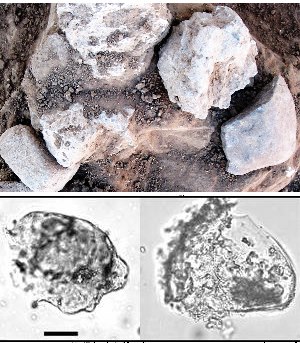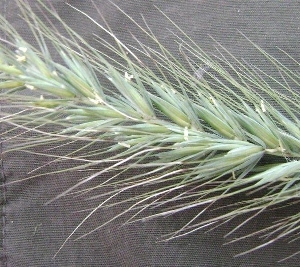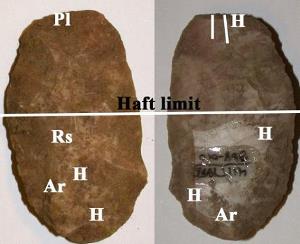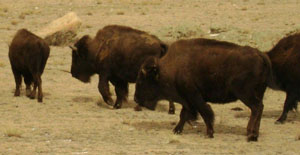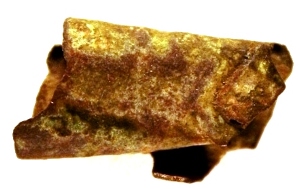Highlights and Future Research
Significant discoveries pertaining to Late Archaic and Protohistoric lifeways were made during the Landis Project. These findings are important for future researchers in a region in which intensive archeological study is infrequent. The discovery of wildrye grass starch grains on ground stone processing tools and burned rocks in the Late Archaic assemblage is a first for this region. It is one of the few instances in which plant usage in prehistoric subsistence patterns has been well documented. The seeds were ground and possibly hammered on sandstone slabs (metates) with stone manos, as evidenced by the damaged starch grains found on these tools. The resultant flour from the seed apparently was then cooked. Lipid residues as well as gelatinized starch grains from burned rocks indicate several different cooking methods were employed: cooking directly on hot rocks as well as in water heated by hot stone rocks (stone boiling). At most open campsites, the plant component of the hunter-gatherer diet frequently is just assumed, due to poor preservation of plant remains. It is remarkable that the Landis evidence revealed not only which plants were gathered (wildrye grass seeds), but also the processing and cooking continuum. Particularly in the Late Archaic diet, these seeds were a supplement to bison products. The discovery of a corner-tang knife in the Late Archaic component also was a rare find. Not only was its discovery unique, but the fact that it was cached under a rock, in anticipation of returning to the camp, is also quite interesting. Dart points from this component also were unusual; these corner-notched points had a longer, more pronounced stem than others commonly found in the region from this time period. Whether this style reflects a specific group of people is not known. INAA analysis to identify raw material sources for tool stone provided critical insights. Chemical signatures of both Alibates flint and Tecovas jasper could be traced to particular outcrops on a fairly discrete level. These local sources were utilized predominantly by prehistoric tool makers in both Late Archaic and Protohistoric times. However, even though the local stone was plentiful and of high quality, these groups also traded for obsidian from the central mountains of New Mexico. Microscopic observation of use-wear provided significant information concerning how the stone tools were used as well as how they were hafted to wooden handles. Apparently the strategy of extending the haft at least to the midpoint of the tool was a consistent mechanism used for all of their hafted stone tools. What advantage this provided the user is not clear, but it is an intriguing finding that warrants further study. As for the Protohistoric camp at the Corral site, it is now clear why we have a difficult time finding and identifying these very late sites. The material remains left behind are very meager and often very similar to that of earlier groups. Clearly, as long as the bison herds were still around, the meat part of the Protohistoric diet remained similar to that of previous generations. By this very late time period, we can confidently assume that much of the stone tool assemblage had been replaced by metal goods that were, understandably, carefully retained and carried away to the next camp. Interestingly, however, a small cache of Alibates flint tools and flakes was found at the Protohistoric site, along with a single metal "tinkler" ornament. The first was an intentional burial, the second no doubt an inadvertent loss, perhaps fallen from the clothing of one of the campers. Following the abandonment of this short-term campsite, its rapid burial by the creek sediments served to seal and preserve the site. This created ideal conditions for archeologists to reconstruct this rare camp. The excellent horizontal spacing of the heating elements, the two stone tool knapping areas, and the trash deposits, including the intentionally discarded ash and expended bison bones near the back side of the terrace, inform archeologist as to how these groups operated in a camp setting. Intensive geoarcheological investigations, also rare for the Panhandle, revealed a complex alluvial history along West Amarillo Creek as well as a suite of data with which to reconstruct the regional and local paleoenvironment. Special studies of pollen, phytoliths, diatoms, ostracods, stable carbon and nitrogen isotopes, and mollusks indicate that environmental conditions were dynamic, periodically fluctuating between cool, moist conditions to warmer, more arid periods. Resources from these wetlands, such as wildrye, made the area highly attractive for visitors. Through these varied investigations and technical analyses, and through a series of educational open houses for the public, the Landis Project has provided new information to help understand Native life on the High Plains.
|
|
